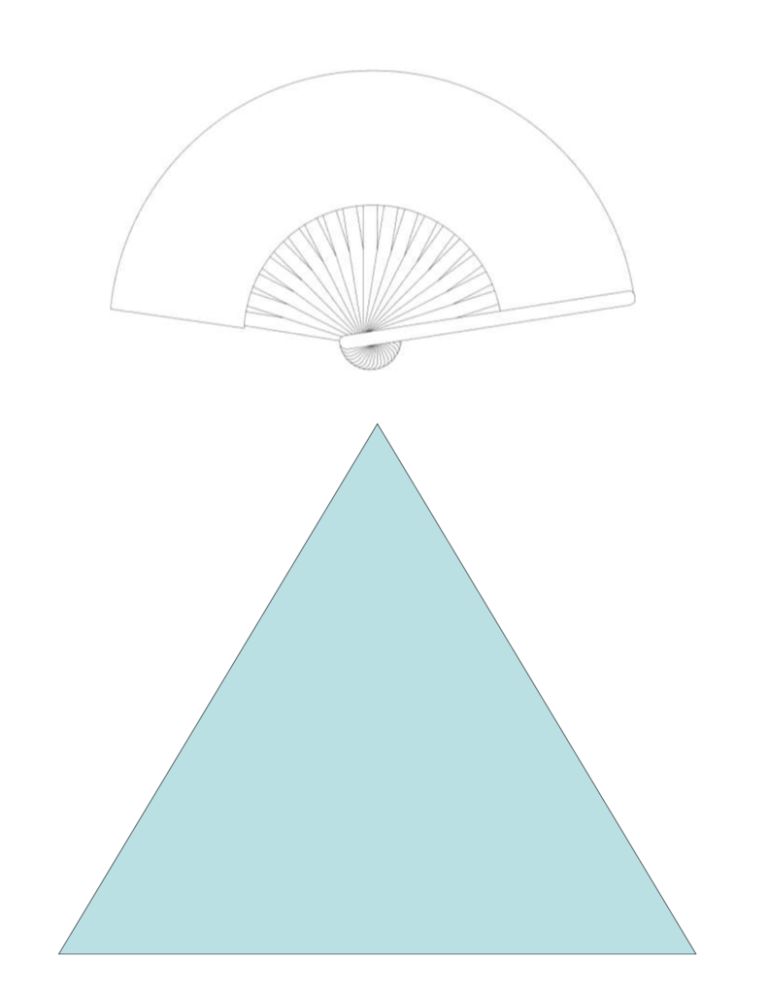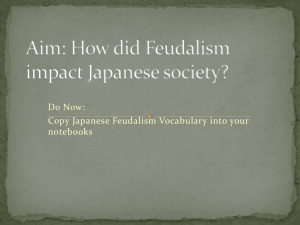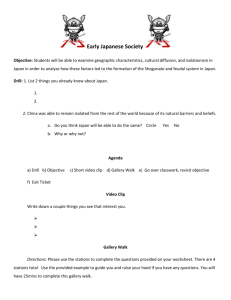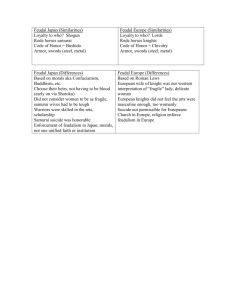Japan Instructions: 1. On the fan outline – create 3 different images
advertisement

Japan Instructions: 1. On the fan outline – create 3 different images that show China’s influence on Japan 2. On the pyramid – draw a pyramid representing the social structure of Japan; explain the roles of each class of society. 3. Venn Diagram: Compare and Contrast the social structures of medieval Europe and Japan China’s Influence on Japan One area deeply influenced by Chinese culture was Japan. Chinese and Korean scholars and merchants brought many aspects of Chinese culture to Japan, a group of islands located close to Korea. Confucianism instilled loyalty to the family and ruler. Buddhism taught the Japanese to renounce selfish desires, while Daoism encouraged love of nature. The Chinese method of writing characters was also adopted in Japan. Chinese music, art, dance, and even cooking influenced Japanese styles and tastes. The Japanese were greatly impressed by the quality of many Chinese goods, such as silks and pottery. The ruler of Japan set up an imperial court, in imitation of China, and declared himself emperor. Social Structure of Japan Between the 12th and 19th centuries, feudal Japan had an elaborate class system. Unlike European feudal society, in which the peasants (or serfs) were at the bottom, the Japanese feudal class structure placed merchants on the lowest rung. Confucian ideals emphasized the importance of productive members of society, so farmers and fishermen had higher status than shop-keepers in Japan. The top of society: Although feudal Japan is said to have had a four tier social system, some Japanese lived above the system, and some below. On the very top of society was the shogun, the military ruler. He was generally the most powerful daimyo; when the Tokugawa family seized power in 1603, the shogunate became hereditary. The Tokugawas ruled for 15 generations, until 1868. Although the shoguns ran the show, they ruled in the name of the emperor. The emperor, his family and the court nobility had little power, but they were at least nominally(in name) above the shogun. The emperor served as a figurehead for the shogun, and as the religious leader of Japan. Buddhist and Shinto priests and monks were above the class system, as well. The Samurai Class: Feudal Japanese society was dominated by the samurai warrior class. Although they made up only about 10% of the population, samurai and their daimyo lords wielded enormous power. When a samurai passed, members of the lower classes were required to bow and show respect. If a farmer or artisan refused to bow, the samurai was legally entitled to chop off the person's head. Samurai answered only to the daimyo for whom they worked. The daimyo, in turn, answered only to the shogun. There were about 260 daimyo by the end of the feudal era. Each daimyo controlled a broad area of land, and had an army of samurai. While most samurai warriors were men, some women were renowned for their skill in battle. A monument was erected to honor Nakano Takeko — a female warrior — at the Hokai temple in Fukushima prefecture because she asked her sister to behead her rather than die dishonorably from a gunshot wound in captivity. Being a warrior in feudal Japan was more than just a job. It was a way of life. The collapse of aristocratic rule ushered in a new age of chaos — appropriately called the Warring States period (c.1400-1600) — in which military might dictated who governed and who followed. The samurai warriors, also known as bushi, took as their creed what later became known as the "Way of the Warrior" (Bushidô), a rigid value system of discipline and honor that required them to live and die in the service of their lords. If commanded, true bushi were expected to give their lives without hesitation. Any form of disgrace — cowardice, dishonor, defeat — reflected poorly on the lord and was reason enough for a bushi to commit suicide by seppuku, or ritual disembowelment. In return for this devotion, the lord provided protection, financial security, and social status — in short, a reason to live. The Farmers / Peasants: Just below the samurai on the social ladder were the farmers or peasants. According to Confucian ideals, farmers were superior to artisans and merchants because they produced the food that all the other classes depended upon. Although technically they were considered an honored class, the farmers lived under a crushing tax burden for much of the feudal era. During the reign of the third Tokugawa shogun, Iemitsu, farmers were not allowed to eat any of the rice they grew. They had to hand it all over to their daimyo, and then wait for him to give some back as charity. The Artisans: Although artisans produced many beautiful and necessary goods, such as clothes, cooking utensils, and woodblock prints, they were considered less important than the farmers. Even skilled samurai sword makers and boatwrights belonged to this third tier of society in feudal Japan. The artisan class lived in its own section of the major cities, segregated from the samurai (who usually lived in the daimyos' castles), and from the lower merchant class. The Merchants: The bottom rung of feudal Japanese society was occupied by merchants, both traveling traders and shop-keepers. Merchants were ostracized as "parasites" who profited from the labor of the more productive peasant and artisan classes. Not only did merchants live in a separate section of each city, but the higher classes were forbidden to mix with them except on business. Nonetheless, many merchant families were able to amass large fortunes. As their economic power grew, the restrictions against them weakened. http://asianhistory.about.com/od/japan/p/ShogJapanClass.htm Although elegant and refined in appearance, Japanese castles were used as military installments. The wood used in their construction allowed these castles to withstand Japan's many earthquakes, but made them susceptible to fire at the same time.





